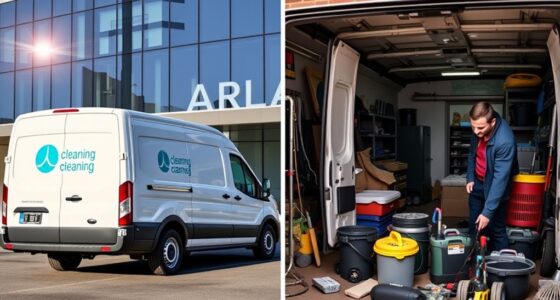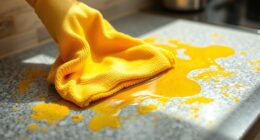By 2025, you’ll need to prioritize green cleaning, automation, and sustainable materials to stay ahead. Customers are demanding eco-friendly solutions, and integrating eco-conscious products and practices can boost your reputation. Automation tools like robotic vacuums and scheduling systems improve efficiency and service quality. Using natural materials enhances your green initiatives and appeals to eco-aware clients. To succeed, staff training on these trends is essential. Keep exploring to discover practical steps for embracing these industry shifts.
Key Takeaways
- Green cleaning will become a standard expectation, with transparency boosting business reputation and aligning with consumer eco-consciousness.
- Automation tools like robotic cleaners and scheduling systems will enhance efficiency and service quality.
- Data-driven operations will enable personalized services, optimize resource use, and uncover new revenue opportunities.
- Incorporating natural materials such as wood and stone will strengthen brands’ sustainable and authentic images.
- Staff training on green practices and automation will be crucial for differentiation and meeting evolving client demands.

As we approach 2025, the cleaning industry is experiencing rapid transformation driven by technological advancements, shifting consumer expectations, and an increased emphasis on sustainability. You need to stay ahead of these trends to remain competitive. One of the most significant shifts is the growing focus on green cleaning. Clients are increasingly demanding environmentally friendly solutions that reduce chemical use and minimize ecological impact. This means you should consider integrating eco-friendly cleaning products and practices into your services. Green cleaning isn’t just a trend; it’s becoming a standard expectation, and failing to adapt could put your business at a disadvantage. Customers appreciate transparency about your eco-friendly initiatives, so showcasing your commitment to sustainability can boost your reputation and attract more clients.
Green cleaning is becoming a standard expectation—adopt eco-friendly practices now to stay competitive and attract eco-conscious clients.
Alongside green cleaning, automation technology is revolutionizing how cleaning services operate. You can now leverage automation tools to streamline workflows, improve efficiency, and reduce labor costs. For example, robotic vacuums and floor scrubbers can handle routine tasks, freeing up your staff to focus on more complex cleaning jobs. Automated scheduling systems help ensure timely service delivery and resource allocation, reducing human error and increasing productivity. Implementing automation technology not only enhances service quality but also appeals to tech-savvy clients who value innovative solutions. As automation becomes more affordable and accessible, integrating these tools into your business operations will be essential to stay competitive and meet client expectations.
Furthermore, automation technology can provide better data collection and analysis, giving you insights into operational performance and client preferences. This data-driven approach allows you to tailor your services more precisely, optimize resource use, and identify new revenue opportunities. It also helps in maintaining compliance with health and safety standards, especially important as clients become more conscious of hygiene and sanitation. Incorporating natural materials such as wood, stone, and linen into your cleaning tools and environments can also enhance your eco-friendly image, aligning with consumer preferences for authenticity and sustainability. The combination of green cleaning and automation technology represents a sustainable, efficient future for the cleaning industry—one where eco-conscious practices are seamlessly integrated with cutting-edge innovations.
To capitalize on these trends, you should invest in training your staff on new green cleaning techniques and automation tools. Educating your team ensures smooth implementation and maximizes the benefits of these advancements. Communicating your commitment to sustainability and technology-driven services can also differentiate your business in a crowded marketplace. As business owners, embracing these trends now will position you as a forward-thinking leader in the cleaning industry, ready to meet 2025’s evolving demands with confidence.
Frequently Asked Questions
How Will AI Impact Cleaning Service Job Roles by 2025?
AI integration will considerably reshape cleaning service roles by 2025. You might see some job displacement as automation handles routine tasks more efficiently, but it also creates opportunities for you to focus on higher-level responsibilities. Embracing AI can boost your productivity and service quality. Staying adaptable and learning new skills will help you remain valuable in an evolving industry, ensuring that AI supports, rather than replaces, your role.
What Eco-Friendly Cleaning Products Will Dominate the Industry?
Your industry is on the brink of a green revolution, and eco-friendly cleaning products will lead the charge. Expect biodegradable packaging to become the standard, drastically reducing waste, and plant-based disinfectants to dominate due to their safety and effectiveness. These products are transforming cleaning routines, making them more sustainable. As a business owner, embracing these innovations guarantees you stay ahead, appealing to eco-conscious clients and championing a healthier planet.
How Can Small Cleaning Businesses Stay Competitive With Emerging Tech?
To stay competitive with emerging tech, you should leverage digital marketing to reach new customers and boost your visibility. Use online platforms to showcase your eco-friendly practices and engage customers through social media, building loyalty and trust. Incorporate user-friendly booking tools and automation to streamline operations. By embracing these technologies, you enhance customer engagement and differentiate your business in a crowded market, ensuring you remain relevant and competitive.
Will Automation Replace Human Workers in Commercial Cleaning?
Picture automation as a powerful tide shaping your cleaning landscape. While robotic vacuums and autonomous scrubbers will handle routine tasks, they won’t fully replace your skilled workers. Instead, they’ll act as trusty allies, boosting efficiency and freeing you to focus on complex jobs that require a human touch. Embrace this wave, and you’ll stay ahead without losing the heart of your business. Automation is a tool, not a substitute.
What New Regulatory Standards Are Expected for Cleaning Chemicals?
You should stay informed about upcoming regulatory standards for cleaning chemicals, especially regarding chemical safety and labeling regulations. Expect stricter rules that demand clearer labeling and safer chemical formulations to protect workers and clients. By proactively updating your products and training staff on these standards, you guarantee compliance and avoid penalties. Keep an eye on government updates to adapt quickly, maintaining your business’s reputation and operational efficiency in an evolving regulatory landscape.
Conclusion
As you navigate the evolving cleaning industry in 2025, staying ahead means embracing new technologies, sustainability, and customer expectations. But the real game-changer? The innovations on the horizon that could redefine your business entirely. Are you ready to adapt and seize these opportunities before your competitors do? The future of cleaning is coming fast—don’t get left behind. Keep your eye on what’s next, because the next big breakthrough might be closer than you think.










